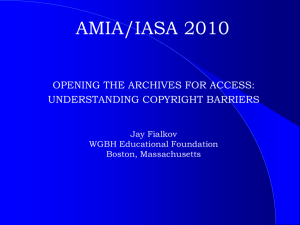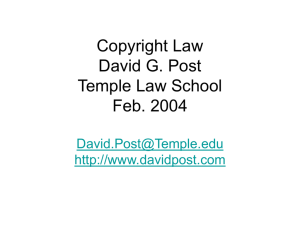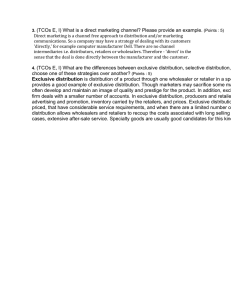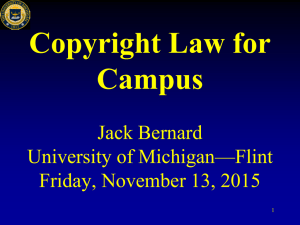Exclusive Rights Granted by Copyright Law - §106
advertisement
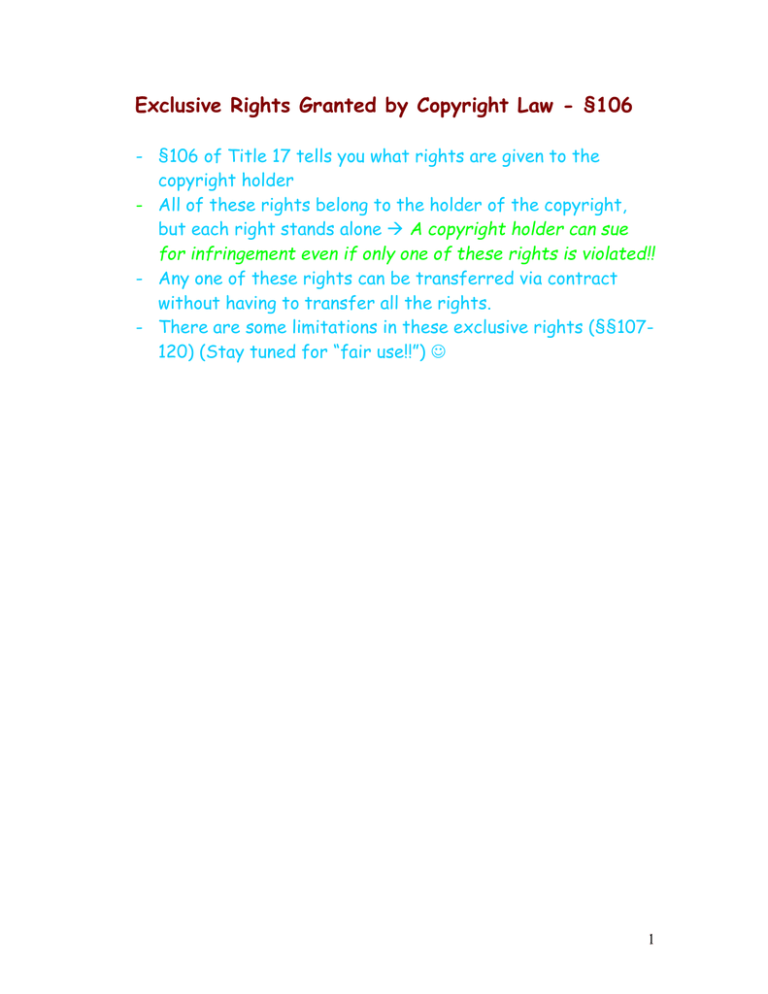
Exclusive Rights Granted by Copyright Law - §106 - §106 of Title 17 tells you what rights are given to the copyright holder - All of these rights belong to the holder of the copyright, but each right stands alone A copyright holder can sue for infringement even if only one of these rights is violated!! - Any one of these rights can be transferred via contract without having to transfer all the rights. - There are some limitations in these exclusive rights (§§107120) (Stay tuned for “fair use!!”) 1 The Exclusive Right to Reproduce – §106(1) - Every © owner has the right to reproduce his original work - An exception to this is §115 – the compulsory license exception - Oddly enough, this is an incentive for © owners to license the work on their own (rather than have the compulsory license kick in. 2 The Exclusive Right to Prepare Derivative Works §106(2) - You must have the author’s permission if you want to create a derivative work. - For a book, a derivative work would be something in the form of a movie/play/show based on the book. - If someone comes along and creates a Broadway show based on the book, and produces the show, he has infringed the copyright of the author. 3 The Exclusive Right to Distribute Copies - §106(3) - This section focuses on what happens when something is done with copies that are already in existence - A copyright owner has the exclusive right to distribute copies of the copyrighted work - §109 puts some limitations on this exclusive right o “First Sale Doctrine” o Gray market goods o Do these two contradict…? 4 The Exclusive Right of Public Performance & Display §106(4) & (5) - “Performance” can be an on-stage play, and it can be a recorded song played on the radio - §110 puts some limitations on this exclusive right, such as performance or display for: (a) Certain educational uses; (b) Religious services; (c) Certain non-profit uses. - “Performance Rights Societies” – ASCAP & BMI o “Blanket licenses” 5 Copyright Infringement - - - Proving that there was illegal copying. How? Merely proving that a copy exists is not enough Must prove that the copy was improper under the statute o Ex. of something that would not be improper: Copying material that is in the public domain 2 tests to prove copying: o Similarity - Look at just how closely the two works resemble each other (keeping in mind that copyright does not protect against independent creation) o Access – it’s unlikely that there was copying if the alleged infringer never saw the copyrighted work © infringement is a strict liability offense - even if you didn’t intend to copy… 6 Remedies for Copyright Infringement - “Cease and Desist” letter o Letter requests that the alleged infringing STOP! o Chilling effect - Injunctions - §502 o Court order to STOP!! o Preliminary injunction o Temporary Restraining Order (TRO) - Impoundment - §503 - Money Damages - §504 o Actual damages o Damages set by statute - Attorney Fees - §505 o Judge will award when appropriate 7 Licensing Agreements & Assignment Agreements Licensing Agreement - The exclusive rights granted in §106 are separable - Non-exclusive license vs. exclusive license - Contract for an option to buy a license at a later date o Another option to negotiate – outright sale of the property Assignment Agreement - To buy the exclusive rights to use an existing book to make a movie, these are some of the documents needed: o Option Agreement for Purchase of Literary Material o Purchase Agreement for Purchase of Literary Materials with Standard Terms and Conditions o Consultant Employment Agreement o Publisher’s Release ALWAYS MAKE SURE YOUR CLIENT’S RIGHTS ARE PROTECTED! 8 Fair Use - §107 - Fair use is a defense against a claim of infringement! - Fair use allows someone to use a protected work without the © holder’s permission. o Examples: criticism, news reporting, parody… 4 factors which must be considered in determining whether a particular use was a fair use: 1. The purpose and character of the use 2. The nature of the copyrighted work 3. The amount and substantiality of the work used 4. The effect the use has on the work’s value A court may take other factors into account as well. Fair use example: Sony Corp. of America v. Universal City Studios, Inc., 464 U.S. 417 (1984). (Betamax video tape recorders) 9
